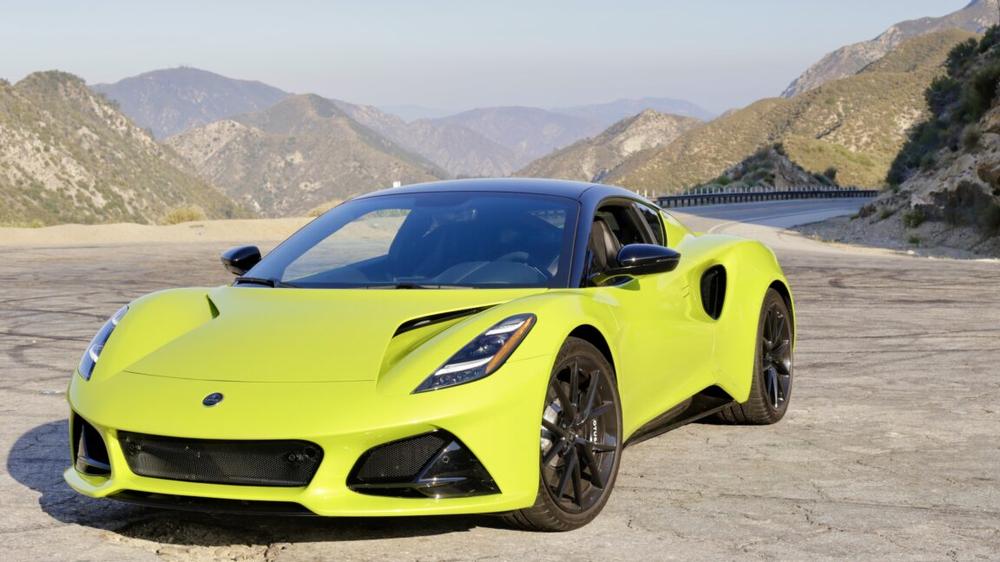The mid-engine sports car is an increasingly rare breed, but Lotus still carries the torch with its Emira, which is available with a choice of supercharged V6 or turbocharged inline-four cylinder engines. Between its steering, compact dimensions, standard manual transmission, and low mass, it’s a breath of fresh air, and it's ready to capture the hearts of enthusiasts. Pricing starts at $102,250 for the V6, which is in direct competition with the Porsche 718 Cayman GTS while it lasts, and a sea of mostly cosmetic options inflated this example to $116,950.
Like many Lotuses before it, the Emira’s foundation is a bonded aluminum chassis with Bilstein passive damper-equipped double-wishbone suspension at all four corners and the engine mounted right behind the seats. Curb weight isn’t as low as you’d think at 3,187 lbs (1,445 kg), but it’s contained within an overall length, width (sans mirrors), and height of 173, 75, and 48 inches (4,395 mm, 1,905 mm, 1,220 mm), respectively.
Mid-engine layouts generally put the same components like radiators in the same places, and the Emira's shape follows its predecessors (as well as cars from McLaren or Ferrari) with large intake ducts straked across its doors and rear fenders, a low nose, and little overhang past the axles. In fact, these are key in its sense-of-occasion appeal; climbing over its door sills and into its driver position is teeming with "let’s go" energy, and the view out the windshield—fenders, short nose, and all—is more exotic than anything else at its price.
Behind the seats is a Toyota-sourced 3.5 L V6. Lotus has tuned the engine and added an Eaton/Edelbrock-sourced supercharger. It revs freely like a sportbike, and it produces a sharp, angry tone anywhere above 2,000 rpm. Adding to the drama is a clear view of the bypass valve in the rear-view mirror, feeding or re-routing boost depending on throttle input. Power is rated at 400 hp (300 kW) and 310 lb-ft (420 Nm) of torque, which feels healthy everywhere—but especially within the final thousand rpm or so. Hitting 60 mph (97 km/h) from a standstill takes just 4.3 seconds.
The shifts could be better
Because it's one of the few remaining manual-equipped sports cars available, I’m conflicted. On the one hand, shifting and rev-matching myself in 2025 is great. On the other hand, the shifter is quite notchy and clunky at times, and while all manual boxes occasionally take a little finessing to slot into first before taking off, the Emira’s frequently require it. Seamless, fast shifts take practice—better to slow down and be more methodical. The rest of the experience is textbook high-end, focused sports car: a nearly formula car-tight pedal box and excellent gearing. I wear a size 12 shoe and had to be very selective in my footwear choices. It was worth it.
Despite looking quite wild, especially in the test car's Isotope Green paint (a $4,500 option), the 2025 Emira is what I’d call enthusiast daily-ready. With Lotus’ sport suspension tuning, it resolved rough and bumpy roads well, keeping me always feeling very connected to what the 245-front and 295-rear Michelin Pilot Sport Cup 2 tires (a $500 option) were dealing with. Ingress and egress aren’t bad thanks to a large door opening, and while over-the-shoulder visibility is tough, there isn’t much Lotus back there, anyway. Even with relaxed throttle inputs, short shifts, and chugging along in the lower rpm range, dipping in and out of lanes and slicing through Los Angeles traffic was easy.
The interior wowed me as well. Lotus has access to parts and components from across the empire of its parent company Geely, and here, the infotainment screen and switchgear are commonly found on lower-tier Geely cars in China. But it was all pleasant to use, and ample Alcantara and stitched leather fill in the rest. The only traits that hamper one's ability to drive the Emira daily are its cupholders and cargo space.
Be careful where you put your groceries
The former are right behind the shifter—only diminutive cappuccino drinks for me. Its 5.3 cubic foot (150 L) trunk is positioned right over the exhaust system, so grocery runs either need to be fast or loaded up on the passenger seat. Sadly, Emira owners can’t enjoy the convenience of a frunk like in Porsche’s Cayman; in its place is a complex system of cooling, which has been upgraded for 2025. On the flipside, though, that upgraded air conditioning is excellent, and it needs to be: The heat from the engine bay soaks in fast, but the car scoffs at playing around on mountain roads on hot summer days.
Those winding roads are the Emira's natural environment. The way the car flows down twisty roads is simply serene due to its talkative and responsive electrohydraulic steering, wonderful chassis communication, minimal body roll, and excellent grip. Between the power-to-weight ratio and vehicle dynamics, it didn’t matter if I wanted to rev out gears before every corner or fly under the radar with the revs low; the Emira was tremendous fun through all varieties of corners.
Hearing the mighty 3.5 change its soundtrack through it all was the cherry on top. Supercharger whine simply never gets old, and after burning through over half a tank of gas in one sitting, coolant temps never got anywhere near concerning.
The brakes are equally enthusiast-ready. The pedal was firm and enabled good modulation, inspiring much confidence. The hardware itself consists of 14.5-inch front and 13.8-inch rear drilled and slotted rotors with big, multi-piston calipers. They exhibited barely any fade as hours went by on one particularly hot afternoon atop the nearby San Gabriel Mountains and had just a hint of grabbiness on city streets when not fully up to temperature.
There’s little to gripe about in Lotus’ latest Emira V6. The example I drove sported Chapman Bespoke badging, too, which is the brand’s division for extensive exterior and interior customization. With sales going generally well for the small British automaker and some help in the form of lower tariffs, I hope these stick around for a good, long while, in spite of some alarming news from last year.

 AI non è un medico, Garante Privacy lancia l'allarme sui rischi
AI non è un medico, Garante Privacy lancia l'allarme sui rischi